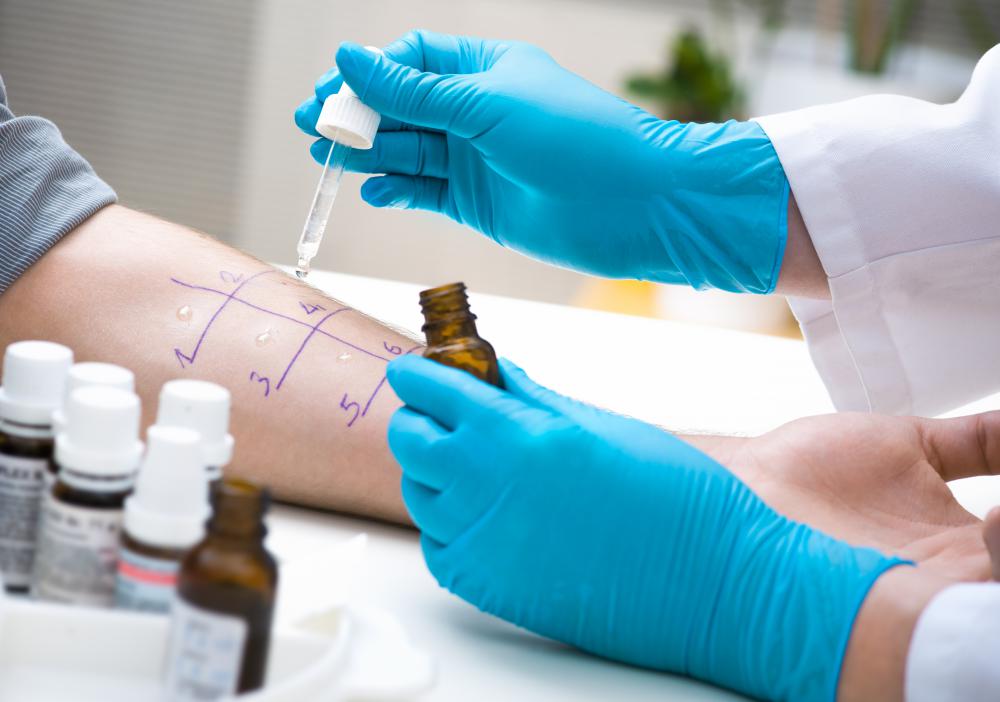At WiseGEEK, we're committed to delivering accurate, trustworthy information. Our expert-authored content is rigorously fact-checked and sourced from credible authorities. Discover how we uphold the highest standards in providing you with reliable knowledge.
What are the Different Types of Allergy Testing?
Allergy testing is usually done by testing the skin or the blood for the presence of a reaction to an allergen. There are three principal types of allergy testing used in modern medicine: skin testing, elimination testing, and radioallergosorbent testing (RAST). Tests done on the skin are more common than lab work on blood, because skin testing is less costly and somewhat more reliable than a blood test. Other testing methods besides those above exist as well, such as the astonishingly simple, yet effective methods used by naturopathic physicians.
Within the category of skin testing, there are three types of tests commonly done. The first of these is called a skin patch test, in which a small pad, moistened with a solution of the allergen in question is taped against the skin for a period of 24 to 48 hours. If the patient is allergic to the substance, an allergic reaction known as contact dermatitis will appear. Allergy testing by this method is fairly reliable, but other, faster methods also exist.

The skin prick test is done by placing a few drops of an allergen in solution onto the person's skin. A needle is then used to scratch or prick the skin enough so that the allergen can enter it. If the person is allergic, a raised, red area will develop on the skin. An intradermal test works in a somewhat similar way. In this method of allergy testing, the allergen solution is injected in small quantities into the skin.

More than one allergy can be tested for at the same time in this way. The one possible drawback to the intradermal method is that is is significantly more sensitive than a skin prick test, and can at times give a false positive. This means that the test results will look as if there is an allergy to that substance, when there is actually not.
When the allergies in question are food allergies, the elimination method of allergy testing is often used. As part of the elimination method, the suspected allergens are eliminated from the person's diet for a period of weeks, and are then reintroduced one by one. The food allergy is detected if an allergic reaction occurs shortly after a certain food is reintroduced. The elimination method can only be used to test for non-life threatening allergies.

If a patient is suffering severe reactions to an unknown allergen, blood testing is usually the preferred method. The RAST test is one of the types of blood testing used in this case. Blood tests measure the levels of antibodies present in the blood, which are produced as part of an allergic reaction. Only a few RAST tests are available, compared to the number of allergies that can be detected through skin testing.
AS FEATURED ON:
AS FEATURED ON:
















Discussion Comments
I have been suffering from asthma. I have had two separate blood exams results are that I have asthma from serious allergies. I was then tested by the skin pricks, first round was negative, second round with needles came back negative again. I have suffered from environmental, food, and allergies to certain materials all my life. Now I am very sick and totally baffled! Any ideas?
@burcidi-- I believe when testing for mold allergies, they use a custom blood test. I heard that this kind of testing is difficult because there is so many different types of mold. Your doctors is only able to test for specific ones. So, even if you have mold allergies, it's hard to pinpoint it in your blood test.
Have you tried UV light? My dad had mold allergies for a while. Our farmhouse is pretty old so mold is also a problem after rain. He had UV light installed in his bedroom and a couple of other rooms. It kills mold and its a really cheap solution. You should try it out and see if your symptoms are better.
I have allergy to mold, even though I've had mold allergy testing and it came back negative. I have all the symptoms (which I know can be similar to pollen allergies. I live in a humid environment and wake up in the night with symptoms after heavy rain. It has to be mold allergies but my blood tests don't show it. Is there another kind of allergy testing I can try?
Post your comments